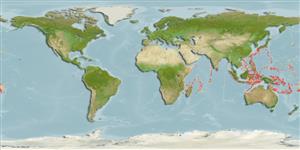Élasmobranches (requins et raies) (sharks and rays) >
Carcharhiniformes (Ground sharks) >
Pentanchidae (Deepwater catsharks)
Etymology: Apristurus: a-, Latin privative, i.e., without; pristis, from pristes (Gr.), sawyer (but here meaning saw); oura (Gr.), tail, referring to absence of saw-toothed crest of enlarged dermal denticles along upper edge of caudal fin as found in the closely related Pristiurus (=Galeus) (See ETYFish); longicephalus: longus (L.), long; cephalus, from kephale (Gr.), head, about ¼ of total length (See ETYFish).
Environment: milieu / climate zone / depth range / distribution range
Écologie
marin bathydémersal; profondeur 680 - 950 m (Ref. 97621). Deep-water; 39°N - 22°S
Indo-West Pacific: Seychelles, Japan, East China Sea, Philippines, and Australia. New specimens were caught off western New Caledonia (Coriolis Bank, Lansdowne Bank, Lord Howe Ridge and Fairway Ridge) and off Mozambique (Ref. 53905).
Length at first maturity / Taille / Poids / Âge
Maturity: Lm 51.0 range ? - ? cm
Max length : 60.0 cm TL mâle / non sexé; (Ref. 559)
Épines dorsales (Total) : 0; Épines anales: 0. Grey-black, without conspicuous markings (Ref. 244).
Inhabits deep water, probably near the bottom (Ref. 11146). Oviparous (Ref. 50449). First record of a cartilaginous fish manifesting rudimentary hermaphroditism (Ref. 53905). Biology little known (Ref. 6871).
Life cycle and mating behavior
Maturité | Reproduction | Frai | Œufs | Fécondité | Larves
Oviparous, paired eggs are laid. Embryos feed solely on yolk (Ref. 50449). First record of a cartilaginous fish manifesting hermaphroditism which is further classified as rudimentary hermaphroditism (Ref. 53905).
Compagno, L.J.V., 1984. FAO Species Catalogue. Vol. 4. Sharks of the world. An annotated and illustrated catalogue of shark species known to date. Part 2 - Carcharhiniformes. FAO Fish. Synop. 125(4/2):251-655. Rome: FAO. (Ref. 244)
Statut dans la liste rouge de l'IUCN (Ref. 130435: Version 2024-2)
Utilisations par l'homme
Pêcheries: intérêt commercial mineur
Outils
Articles particuliers
Télécharger en XML
Sources Internet
Estimates based on models
Preferred temperature (Ref.
123201): 5.2 - 7.4, mean 6 °C (based on 99 cells).
Phylogenetic diversity index (Ref.
82804): PD
50 = 0.5000 [Uniqueness, from 0.5 = low to 2.0 = high].
Bayesian length-weight: a=0.00355 (0.00175 - 0.00721), b=3.08 (2.90 - 3.26), in cm total length, based on LWR estimates for this (Sub)family-body shape (Ref.
93245).
Niveau trophique (Ref.
69278): 3.9 ±0.4 se; based on size and trophs of closest relatives
Résilience (Ref.
120179): Très faible, temps minimum de doublement de population supérieur à 14 ans (Fec assumed to be <10).
Fishing Vulnerability (Ref.
59153): Moderate vulnerability (44 of 100).
